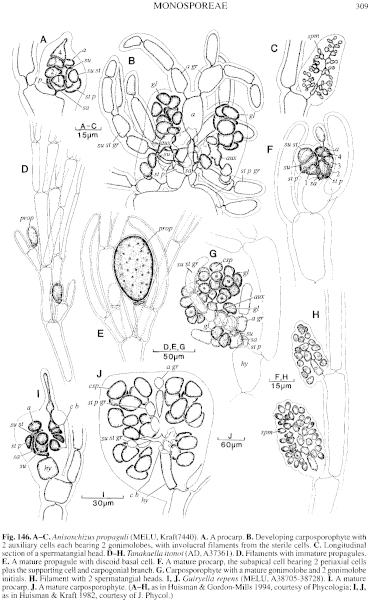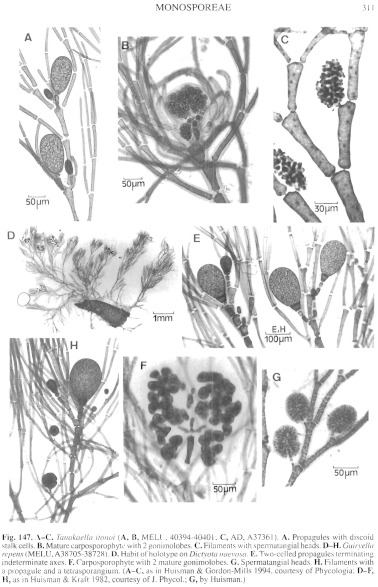|
|
|
|
|
|||||||||||
|
Electronic Flora of South Australia Species Fact Sheet
Phylum Rhodophyta – Order Ceramiales – Family Ceramiaceae – Tribe Monosporeae
Selected citations: Huisman 1997: 198. Silva et al. 1996: 413.
Thallus (Fig. 147D) erect from a prostrate base, dark red-brown, 2–10 mm high, much branched irregularly radially with subdichotomous 4–6-celled laterals from most cells and indeterminate axes every 2–5 cells, mature axes more or less alternately distichous, apices overtopped by laterals. Attachment of prostrate filaments by unicellular rhizoids with digitate haptera; epiphytic on Dictyotales. Structure. Apical cells 10–16 µm in diameter and L/D 2–6, lower cells of determinate laterals 10–30 µm in diameter and L/D 6–10, cells of indeterminate laterals and axes 45–75 µm in diameter and L/D 2–6; prostrate axes 50–180 µm in diameter, cells L/D 3–4. Cells multinucleate; rhodoplasts discoid to elongate.
Reproduction: Propagules (Fig. 147E, H) 2-celled, ovoid, 100–140 µm in diameter with the basal cell trapeziform, terminating short indeterminate branches with a 2-celled stalk, with the upper propagule cell much larger than the lower.
Gametophytes dioecious. Procarps (Fig. 146I) borne on the subapical cell of short axes, with 3 periaxial cells, one acting as the supporting cell and bearing a carpogonial branch and a sterile cell, and a larger hypogenous cell. Post-fertilization the supporting cell and adjacent periaxial cell cut off auxiliary cells, with 2 connecting cells from the carpogonium; carpogonial branch cells fuse and later degenerate. Each auxiliary cell produces a gonimolobe (Figs 146J, 147F) 200–300 µm across, of ovoid carposporangia 35–50 µm in diameter. Sterile procarp cells (apical, sterile periaxial and supporting sterile cells) each divide once to produce short 2-celled branches; no other involucral branches occur. Spermatangial heads (Fig. 147G) are ovoid, 30–50 µm in diameter, on cells of laterals, with 2–3 axial cells bearing whorls of cells with outer spermatangia.
Tetrasporangia (Fig. 147H) occur on the upper ends of cells of laterals, subspherical with thick wall sheaths, 60–80 µm in diameter, tetrahedrally divided.
Type from Pelsaert Group, Houtman Abrolhos, W. Aust., on Dictyota naevosa, 20 m deep (Kraft & Huisman. 14.x.1990); holotype in MELU, A38705.
Selected specimens: Roe Reef, Rottnest I., W. Aust., on brown algae, 12 m deep (Huisman, 15.iv.1989; Murdoch, JH 670). Tiparra Reef, S. Aust., on Dilophus robustus, 10–12 m deep (Shepherd, 16.iii.1985; AD, A56438). 4 km off Seacliff, S. Aust., 13m deep (Rowland, 5.iii.1988; AD, A58636). ?Port Noarlunga, S. Aust., drift (Womersley, 20.iii.1969; AD, A33778).
Distribution: Houtman Abrolhos to Rottnest I., W. Aust., and Tiparra Reef to Port Noarlunga, S. Australia.
References:
HUISMAN, J.M. & KRAFT, G.T. (1992). Disposal of auxiliary cell haploid nuclei during post-fertilisation development in Guiryella repens gen. et sp. nov. (Ceramiaceae, Rhodophyta). Phycologia 31(2), 127–137.
HUISMAN, J.M. (1997). Marine Benthic Algae of the Houtman Abrolhos Islands, Western Australia. In Wells, F.E. (Ed.) The Marine Flora and Fauna of the Houtman Abrolhos Islands, Western Australia, pp. 177–237. (W. Aust. Museum: Perth.)
SILVA, P.C., BASSON, P.W. & MOE, R.L. (1996). Catalogue of the Benthic Marine Algae of the Indian Ocean. (University of California Press: Berkeley, Los Angeles & London.)
The Marine Benthic Flora of Southern Australia Part IIIC complete list of references.
Publication:
Womersley, H.B.S. (24 December, 1998)
The Marine Benthic Flora of Southern Australia
Rhodophyta. Part IIIC. Ceramiales – Ceramiaceae, Dasyaceae
©State Herbarium of South Australia, Government of South Australia
Illustrations in Womersley Part IIIA, 1998: FIGS 146 I, J, 147 D–H.

Figure 146 enlarge
Fig. 146.A–C. Anisoschizus propaguli (MELU, Kraft7440). A. A procarp. B. Developing carposporophyte with 2 auxiliary cells each bearing 2 gonimolobes, with involucral filaments from the sterile cells. C. Longitudinal section of a spermatangial head. D–H. Tanakaella itonoi (AD, A37361). D. Filaments with immature propagules. E. A mature propagule with discoid basal cell. F. A mature procarp, the subapical cell bearing 2 periaxial cells plus the supporting cell and carpogonial branch. G. Carposporophyte with a mature gonimolobe and 2 gonimolobe initials. H. Filament with 2 spermatangial heads. I, J. Guiryella repens (MELU, A38705-38728). I. A mature procarp. J. A mature carposporophyte. (A–H, as in Huisman & Gordon-Mills 1994, courtesy of Phycologia; I,J, as in Huisman & Kraft 1982, courtesy of J. Phycol.)

Figure 147 enlarge
Fig. 147. A–C. Tanakaella itonoi (A, B, MELU, 40394-40401; C, AD, A37361). A. Propagules with discoid stalk cells. B. Mature carposporophyte with 2 gonimolobes. C. Filaments with spermatangial heads. D–H. Guiryella repens (MELU, A38705-38728). D. Habit of holotype on Dictyota naevosa. E. Two-celled propagules terminating indeterminate axes. F. Carposporophyte with 2 mature gonimolobes. G. Spermatangial heads. H. Filaments with a propagule and a tetrasporangium. (A–C, as in Huisman & Gordon-Mills 1994, courtesy of Phycologia; D–F, H, as in Huisman & Kraft 1982, courtesy of J. Phycol.; G, by Huisman.)

|
Email Contact: State Herbarium of South Australia |

|